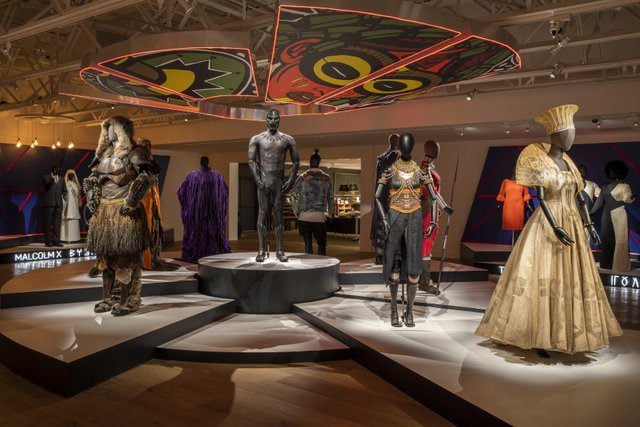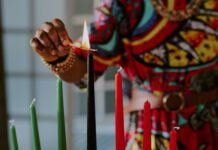
“Ruth E. Carter: Afrofuturism in Costume Design” is coming to The Children’s Museum of Indianapolis March 22.
The exhibition features more than 60 costumes from films Carter worked on, such as “Black Panther” and “Black Panther: Wakanda Forever,” “Coming 2 America,” “Roots (2014),” “Selma” and more. The Recorder sat down with the Oscar Award-winning costume designer ahead of the exhibition to discuss inspirations, storytelling and collaborating with actors to bring characters to life on screen.
Responses have been edited for clarity and brevity.
Was costume design something you always knew you wanted to do? When or how did you know that’s where your talents and passions crossed?
Carter: I didn’t always know costume design was my path, but I always was drawn to storytelling and being an artist. It clicked for me when I was in college, when I realized how costumes could bring characters and cultures to life. I made the theater and costume design shop my learning lab, and that’s where my passion for design and storytelling merged and a career followed suit.
You’ve won a plethora of awards for your work, most recently for “Black Panther: Wakanda Forever.” What does it mean to have this type of art acknowledged and celebrated on such a big stage?
Carter: It’s an incredible honor. I started when costume design was little sought after in terms of what it was about and how it was a collaborative medium. I just had such a passion for it, and I held it up in such a big way in terms of I was bringing characters (to life) that I saw in paintings — the paintings of Romare Bearden or the photography of Gordon Parks.
I loved culture so much I wanted to see those characters on the big screen. So, we fast forward to having the accolades and the honors, like for “Black Panther,” and it just means my deepest passion was correct. It’s so validating to be honored in that way, and also people saw my passion in my work, and that’s what really means the most to me.

Your work is intentional about bringing in historical and cultural references that many people do not know. Why is that so important for you to do? How do you get started with your research?
Carter: I start with going and collecting all of the information that I know about a certain period of time, a certain tribe of Africa (or) a certain time and place in this country where Black people or cultures converged, and I look at the facts. My first encounter is to look at the facts as well as look at other artists of the time because a lot can be drawn from other artists as well. So, you see their paintings, and you start understanding what their world was like.
That process really brings me a lot of joy. Sometimes, I just want the characters to leap off the page that I’m researching and just come into my world, but I have to actually physically dissect everything that I see, that they’re wearing, and why. I need to know why they’re wearing it.
READ MORE: First Black chess grandmaster visits St. Richard’s Episcopal School
Costumes are such a significant part of storytelling. How do you portray each character’s personality in their clothing and style?
Carter: I try to be connected with the actors because I can create a character that I think is going to show those traits, but I have to collaborate with the actors. The actors give me pointers about how they’re going to portray the character as shy. It’s a collaborative process when you really want to portray different traits about a person’s personality because I’m not in front of the camera; the actors are.
In storytelling, characters evolve. Can you describe how a character’s style may change throughout a film?
Carter: Yes, if you remember Nakia in the first “Black Panther,” she was a war dog, she was a spy, but she was also a princess and a girlfriend. The only color that she could wear was green because in “Black Panther,” we had a very calculated color palette for each character.
So, when she was a spy and she was entering the casino scene, we put her in this very chic dress because she was around a lot of people who were world travelers. When she was a war dog, she was a captive in this small space of women who were all captives, and they covered their hair, so she had to blend and be exactly like they were. When she was a girlfriend on a date with T’challa, she wore a playful jumpsuit with one shoulder out and the patterns on the jumpsuit were playful. You go along with where they are, what they’re doing and what role this one character is playing.
On the other hand, it sometimes is a very subtle journey.
When we do a story like Thurgood Marshall that Chadwick Boseman played, we knew that he was a lawyer who was doing a lot of pro bono work for the Civil Rights in the South. He traveled on trains, and he traveled to distant lands; he probably walked a great distance from the train stop to his clients, and we had to show that in his clothes. His clothes may have started out at the top of the day looking crisp, but as he journeyed along, his shoes were more dusty and his suit jacket looked more sat in and weathered.
So, you take the journey alongside the actors, and the script is what really tells you how to connect the storytelling with what’s going what we’re going to see in the costumes.
What do you hope kids and their families learn from this exhibition? What are you hoping to inspire in younger generations about costume design or storytelling?
Carter: I hope that they see my work as being more than just costumes. It’s about creating a visual language that connects people to story, culture and emotion. My exhibition is a celebration of that journey and an opportunity to showcase the artistry behind costume design and its role in storytelling. I hope it inspires visitors to see the power of design and creativity in shaping narratives and encourages them to explore their own creative paths.
“Ruth E. Carter: Afrofuturism in Costume Design” is on display at the Children’s Museum of Indianapolis beginning March 22. For more information, visit, childrensmuseum.org/ruth-carter-afrofuturism.
Contact Arts & Culture Reporter Chloe McGowan at 317-762-7848. Follow her on X @chloe_mcgowanxx.
Chloe McGowan is the Arts & Culture Reporter for the Indianapolis Recorder Newspaper. Originally from Columbus, OH, Chloe has a bachelor's in journalism from The Ohio State University. She is a former IndyStar Pulliam Fellow, and has previously worked for Indy Maven, The Lantern, and CityScene Media Group. In her free time, Chloe enjoys live theatre, reading, baking and keeping her plants alive.




